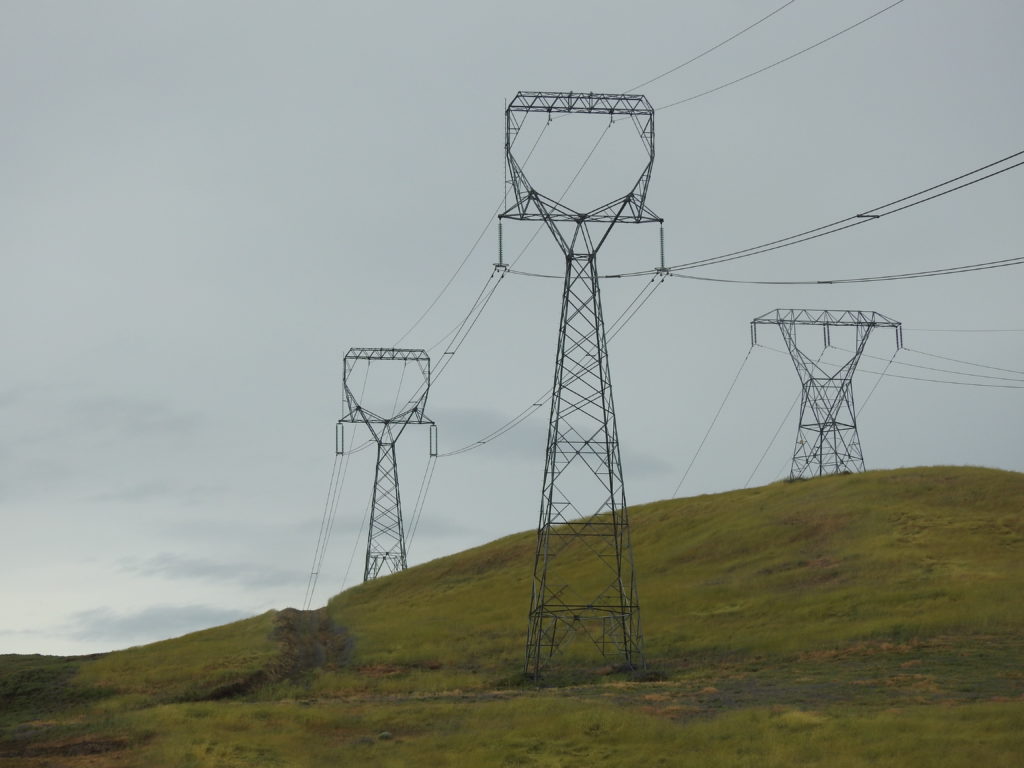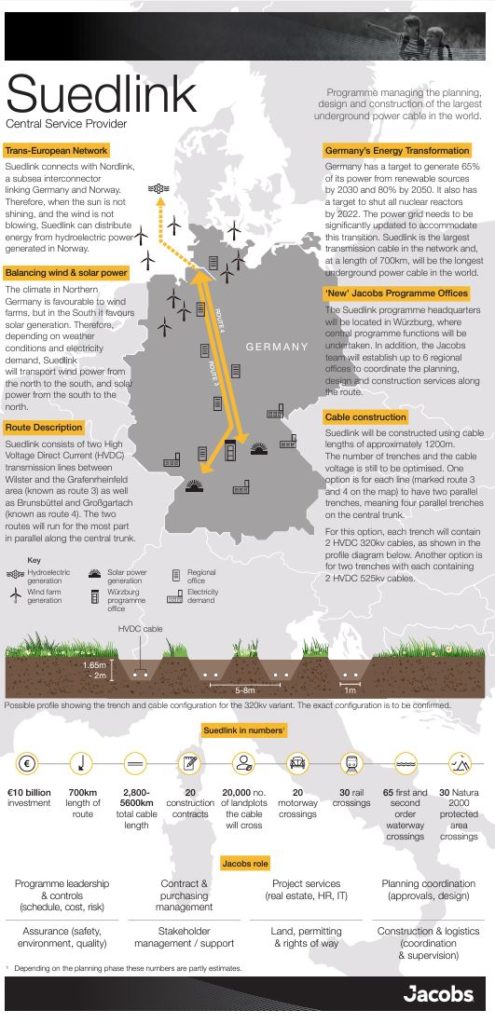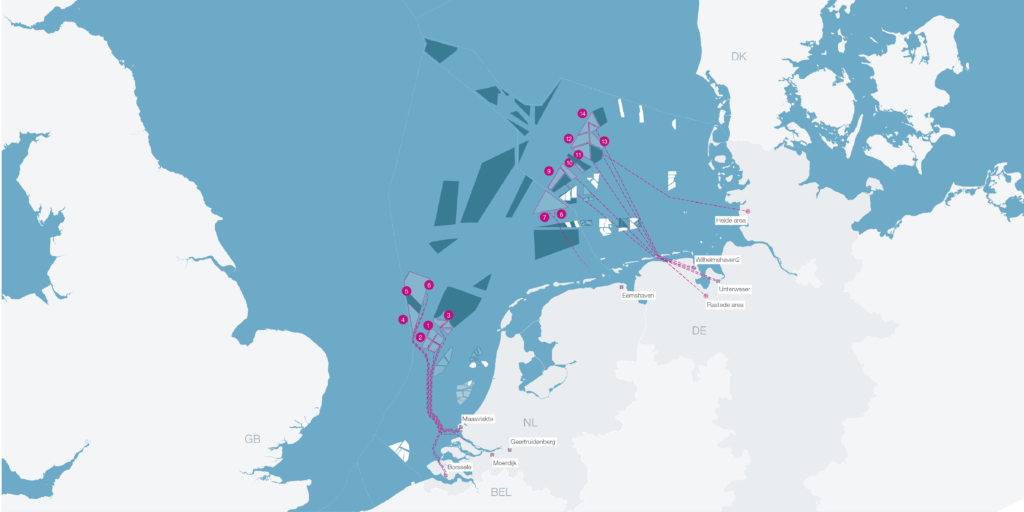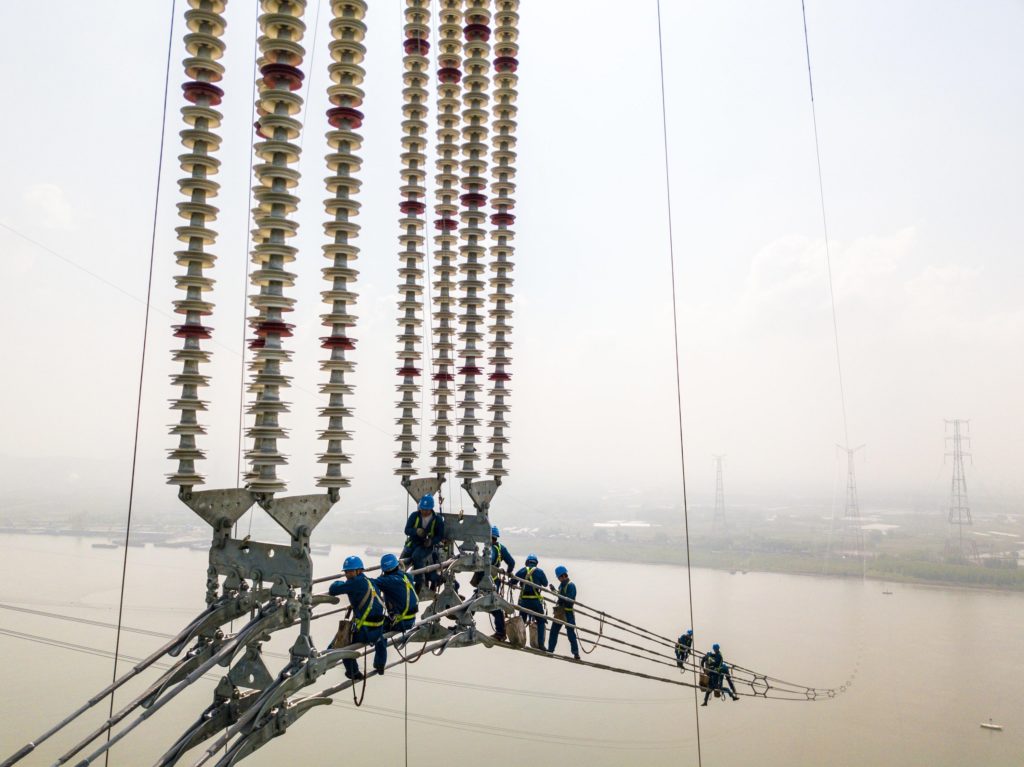In most parts of the world, it takes time, a lot of it, to get the necessary permits to build a new transmission line. While few dispute the benefits of and need for more electric transmission, many oppose the lines to be built. The reasons can be several, but in most cases, it comes down to NIMBY (Not-In-My-Backyard).

Pacific Intertie, a breakthrough transmission system at its time, initially, 1969, with a capacity of 2500 MW. With subsequent expansions the 400 kV HVDC line and the two 500 kW HVAC lines can bring 7900 MW of predominantly hydro power from the Pacific Northwest to the Los Angeles area. Photo by the author.
The common denominator for transmission projects moving ahead is thorough planning and persistence in working with public opinion and permitting authorities. For individual projects creativity and unconventional approaches can be effective enabling the project to happen. Below are some ongoing projects worth watching and learning from.
Suedlink, Germany. Suedlink is the key HVDC project connecting north and south in Germany. More precisely, Suedlink is composed of two lines, each at 2 GW. The need for Suedlink was identified well over a decade ago as a pivotal component for the German Energiewende. Despite huge efforts by the two electric utilities, TenneT and TransnetBW, with town hall meetings and resulting route modifications, the opposition against the overhead transmission lines was overwhelming. The project stalled in the permitting process. Only after the German Government in 2016 allowed rate recovery for underground cables instead of overhead lines, the planning and permitting process could proceed, again with extensive public participation. In March 2021, the route corridor was approved. Eventually, in September this year (2023) construction could start. It is expected to be completed in 2028, six years later than originally planned. The cost increase to go underground is estimated to be about $4 billion, which brings the total estimated cost to $13 billion. Nevertheless, it is “only” a 30% increase, not the “ten times more” routine argument against undergrounding.

Suedlink fact sheet. TenneT and TransnetBW awarded Jacobs with contracts for wide ranging support services to the project. Source: Jacobs.
Champlain Hudson Express, USA. This project is a 1250 MW HVDC transmission line from Quebec to New York City. The length is 339 miles. The estimated cost is about $6 billion. The target completion is 2026. Champlain Express has been over 15 years in the making. The project was launched in 2006 but was shelved in 2009 after strong opposition from several groups concerned about the impact of the transmission towers. Like Suedlink, permitting was the main challenge. The solution was to eliminate overhead lines, by using waterways for 60% of the length and underground for the remaining 40%.
SunZia, USA. The purpose of this transmission project is to connect a very large wind development, 3500 MW, in New Mexico with load in Arizona and California. It will be 550 miles long HVDC link between Corona, NM, and Pinal, AZ. The line is rated ±525 kV with a capacity of 3000 MW. The wind farm as well as the transmission line is developed by the same owner, Pattern Group. Also, here the biggest challenge has been getting approvals. The final approval from Bureau of Land Management (BLM) was received in May this year (2023), followed four months later by groundbreaking. The target for the start of commercial operation is 2026. However, it may be delayed. BLM put the project along a fifty mile segment of the line temporarily on hold after a native American tribe raised concerns about effects on religious and cultural sites along this tract.
TransWest Express, USA. Like the SunZia TransWest Express aims at connecting a large wind development in Wyoming with load in Nevada and California. TransWest Express has two sections. The first section is 732 miles long HVDC line from Sinclair, Wyoming, to Delta, Utah. It is rated 3000 MW. The second section is an AC transmission at 1500 MW from Delta to Las Vegas area, Nevada. From southern Nevada there are already very strong electric ties with California, about 10 GW. The section from Delta to Las Vegas follows Path 27, which is the path of the Intermountain HVDC line between Delta to Adelanto, California. As a note of curiosity, the Intermountain HVDC line was built in 1991 connecting an 1800 MW coal plant with load in the Los Angeles. The coal plant will now be retired and replaced with an 840 MW gas plant, which will use a gas mixture with 30% hydrogen. The target is to run on 100% hydrogen by 2045.
TransWest Express’ development started in 2005. In 2007 the project received a preliminary right-of-way (ROW) from BLM, but it was not until April this year (2023) that the project got its Notice To Proceed from BLM. Construction started five months later. Target completion is 2027.
SunZia and TransWest Express have in common that for both projects the same owner develops both the wind farm and the transmission line(s). Without the transmissions lines to reach load centers the wind projects are not economical. The SunZia transmission project was initiated by Southwestern Power Group. In July 2022, Pattern Energy Group LLC acquired the project. In the case of TransWest the Anschutz Group has, through the subsidiary Power Company of Wyoming, been the developer of wind farms Chokecherry and Sierra Madre from the start. The transmission project was initiated by National Grid, from whom the Anschutz Group acquired the project in 2008.
For offshore wind developments transmission is a prerequisite. The largest offshore wind development in the world is in the North Sea. Just for Germany and the Netherlands TenneT, the world’s leading electric utility of offshore wind integration, has already integrated 10 GW of offshore wind. The target is to have 26 GW by 2030. Nine countries (Norway, Sweden, Denmark, Belgium, The Netherlands, Germany, France, Ireland, and Luxemburg) of the European Union has pledged to build 300 GW of offshore wind by 2050. Such massive developments will require innovative approaches for the transmission systems. For that purpose, TenneT has forged innovative partnerships with leading market participants like Siemens and Hitachi Energy developed the 2GW Program, which has standardized” one-fits-all” 2 GW HVDC offshore platforms and a new 525 kV bipolar cable system.
Bringing all the offshore wind to load also requires the existing bulk electricity system on land to be strengthened. Worthwhile noticing is how TenneT and Elia (Belgium) has about doubled the capacity on some of their bulk transmission lines by reconductoring with advanced conductors.

TenneT 2GW Program presently includes the interconnections of 6 German and 8 The Netherlands offshore wind projects, planned to be commissioned 2029 to 2031.
China is already leading the world in deploying HVDC transmission, not only in number of projects, but also in terms of the size of the projects. The State Grid Corporation of China proposed in 2004 the idea of deploying ultra high voltage transmission lines, both AC and DC, at 1000 kV and 800 kV, respectively. The first such projects were completed in 2009 and 2010. The Ultra HVDC (UHVDC) lines enable developing massive remote renewable energy sources, hydro, wind and solar, in the western parts of China and bring the power to population centers in the east with a minimum of transmission losses. Seventeen UHVDC projects have already been completed. Just this year (2023) three new UHVDC project started this year:
- Jinshang – Hubei, 1900 kilometers, ±800 kV DC, 8 GW
- Longdong- Shangdong, 926 kilometers, ±800 kV DC, 8 GW
- Ningxia – Hunan, 1634 kilometers, ±800 kV DC, 17.6 GW
While permitting in China is much less of an issue compared to USA and Europe, it does not mean building these UHVDC lines are without issues. For example, one can imagine conflicting interests between local, regional, and national. There are also delicate grid reliability issues to solve, such as meeting N-1 criteria as well as mitigating the risk for cascading events, but so far, the deployment of the UHVDC has been successful.

From the construction of the Changji – Guquan UHVDC transmission line, here at the Yangtse River (2018). Photo: Imaginechina Limited, Alamy Stock Photo.
The above transmission projects illustrate considerable progress in getting large scale transmission built. The technology is there all the way up to ultra high voltage, supplemented with high capacity cables and advanced conductors. Standardization like TenneT’s 2G Program and the China UHVDC program help bring costs down. Public acceptance and permitting remain, with a few exceptions, the biggest obstacle to building new bulk transmission lines. There are no shortcuts. Transparency and persistence are key, but also creativity such as using underground/submersible cables as well as maximizing existing ROW, including rebuilding or reconductoring existing transmission lines.